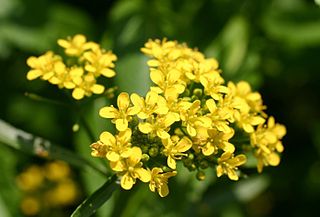
Rorippa is a genus of flowering plants in the family Brassicaceae, native to Europe through central Asia, Africa, and North America. Rorippa species are annual to perennial herbs, usually with yellow flowers and a peppery flavour. They are known commonly as yellowcresses.

Atriplex argentea is a species of saltbush known by the common names silverscale saltbush and silver orache. It is native to western North America from southern Canada to northern Mexico, where it grows in many types of habitat, generally on saline soils.

Orobanche fasciculata is a species of broomrape known by the common name clustered broomrape. It is native to much of western and central North America from Alaska to northern Mexico to the Great Lakes region, where it grows in many types of habitat. It is a parasite growing attached to the roots of other plants, usually members of the Asteraceae such as Artemisia; and other genera such as Eriodictyon and Eriogonum. This plant produces one or more stems from a bulbous root, growing erect to a maximum of about 20 centimeters in height. The stems, leaves and five-lobed flowers are covered by sticky hairs. As a parasite taking its nutrients from a host plant, it lacks chlorophyll as well as a water-storage system. It is variable in color, often yellowish or purple. The inflorescence is a raceme of up to 20 flowers, each on a pedicel up to 15 centimetres long. Each flower has a calyx of hairy triangular sepals and a tubular corolla 1.5–3 cm long. The flower is yellowish or purplish in color.

Rorippa palustris, marsh yellow cress, is a species of flowering plant in the family Brassicaceae. It is widespread and native to parts of Africa, and much of Asia, Europe and Eurasia, North America and the Caribbean. It can also be found in other parts of the world as an introduced species and a common weed, for example, in Australia and South America. It is an adaptable plant which grows in many types of damp, wet, and aquatic habitat. It may be an annual, biennial, or perennial plant, and is variable in appearance as well.

Rorippa austriaca is a species of flowering plant in the family Brassicaceae known by the common names Austrian yellow-cress and Austrian fieldcress. It is native to parts of Europe and Asia, and it is known in North America as an introduced species and sometimes a noxious weed. It can grow in disturbed habitat, such as roadsides, and in very wet habitat such as mudflats. It is a perennial herb growing upright to erect, reaching a maximum height near one meter. The branching stem bears hairless blue-green lance-shaped leaves up to 10 centimeters long. The bases of the upper leaves clasp the stem. The inflorescence is a raceme at the top of the stem and the ends of stem branches. The mustardlike flowers have small yellow petals. The fruit is a plump silique a few millimeters long, but many plants do not fruit and seed production is rare. Reproduction in this species is more often vegetative, the plants concentrating their growth in belowground tissue and spreading clonally. The root system of the plant is particularly aggressive, sending up many new plants as it spreads.
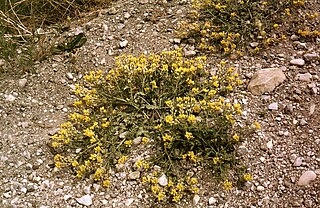
Rorippa columbiae is a species of flowering plant in the family Brassicaceae known by the common names Columbian yellowcress and Columbia yellow cress.

Rorippa curvipes is a species of flowering plant in the family Brassicaceae known by the common name bluntleaf yellowcress. It is native to much of western North America from Alaska to Mexico to the Mississippi River, where it can be found in various types of moist and wet habitat, including lakeshores and riverbanks, meadows, roadsides, mudflats, and irrigation ditches. It is an annual or perennial herb, producing several stems growing prostrate along the ground or somewhat upright, measuring 10 centimeters to around half a meter in maximum length. The leaves are long and narrow, smooth edged or lobed, the lobes sometimes cut all the way to the midrib or separated to form leaflets. Lower leaves are borne on petioles; upper leaves have bases that clasp the stem. The mustardlike flowers have very small yellow petals. The fruit is a plump, hairless silique containing many minute seeds.
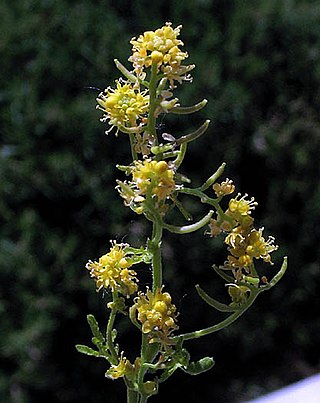
Rorippa curvisiliqua is a species of flowering plant in the family Brassicaceae known by the common name curvepod yellowcress.
Rorippa sphaerocarpa is a species of flowering plant in the family Brassicaceae known by the common name roundfruit yellowcress. It is native to North America, including the western United States and northern Mexico, where it grows in moist habitat, such as riverbanks and mudflats. It is an annual herb producing decumbent or erect stems up to 40 centimeters long. The leaves are up to 10 centimeters long and have blades are deeply divided into toothed lobes. The inflorescence is a raceme of mustardlike flowers with yellow petals each no more than a millimeter long. The fruit is a round silique 1 or 2 millimeters wide.

Rorippa subumbellata is a rare species of flowering plant in the family Brassicaceae known by the common names Lake Tahoe yellowcress and Tahoe yellow cress. It is known only from the shores of Lake Tahoe, straddling the border between California and Nevada. There are an estimated fourteen populations of the plant still in existence. It grows only on the direct shoreline of the lake, occupying a seven-foot semi-aquatic zone between the high- and low-tide marks. It is directly impacted by recreational activities on the lake, enduring bombardment by boat wakes, trampling, and construction of docks and other structures.

Rumex salicifolius is a species of flowering perennial plant in the knotweed family known by the common names willow dock and willow-leaved dock. It is native to much of western North America, and more specifically, in southern and central parts of California, and some parts of Arizona and Nevada. It can also be found in parts of Europe as an introduced species and a roadside weed. It is an extremely variable plant which is generally divided into many varieties, some of which may actually be specimens of other species.
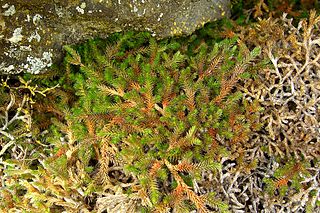
Selaginella wallacei is a species of spikemoss known by the common name Wallace's spikemoss. It is native to western North America from British Columbia to California to Montana, where it can be found in many types of habitat, including open and shaded areas, and wet to dry environments, often growing on and over rocks. This lycophyte is variable in appearance, its form depending on the habitat it grows in. It can be spreading with many narrow branches, or a small, dense mat. The forking stems grow up to about 25 centimeters long, but may remain much shorter in dry conditions. They are lined with linear, lance-shaped, or oblong leaves up to 4 millimeters long including the bristles at the tips. The strobili containing the reproductive structures may be quite long, reaching up to 9 centimeters.
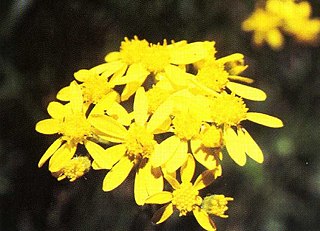
Senecio hydrophilus is a species of flowering plant in the aster family known by the common names water ragwort and alkali-marsh ragwort. It is native to western North America from British Columbia to California to Colorado, where it grows in swampy places such as marshes. It can grow in standing water, including alkaline and salty water. It is a biennial or perennial herb producing a single erect stem or a cluster of a few stems which may exceed one meter in maximum height, at times approaching two meters. The stem is hollow, waxy in texture, and often pale green in color, and it emerges from a small caudex. The thick leaves are lance-shaped to oval with smooth or toothed edges, the blades up to 20 centimeters long and borne on petioles. Smaller leaves occur farther up the stem. The inflorescence is one or more large, spreading clusters of many flower heads. They contain many yellowish disc florets at the center and sometimes have small yellow ray florets as well.
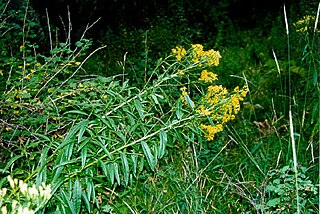
Senecio serra is a species of flowering plant in the aster family known by the common names tall ragwort and sawtooth groundsel. It is native to the western United States, where it can be found in several types of habitat, including sagebrush and woodlands. It is a perennial herb producing a single erect stem or a cluster of stems from a branched, woody caudex. The plant can exceed two meters in height. It is hairless in texture, with young plants sometimes appearing fuzzy, and green to red-tinged in color. The leaves have lance-shaped blades up to 20 centimeters long borne on short petioles, the leaves occurring evenly all along the stems. The inflorescence is a spreading array of many flower heads, each lined with green- or black-tipped phyllaries. The heads contain yellow disc florets and 5 to 8 yellow ray florets each under a centimeter long.

Senecio sylvaticus is a species of flowering plant in the aster family. It is variously known as the woodland ragwort, heath groundsel, or mountain common groundsel. It is native to Eurasia, and it can be found in other places, including western and eastern sections of North America, as an introduced species and an occasional roadside weed. It grows best in cool, wet areas. It is an annual herb producing a single erect stem up to 80 centimeters tall from a taproot. It is coated in short, curly hairs. The toothed, deeply lobed leaves are up to 12 centimeters long and borne on petioles. They are evenly distributed along the stem. The inflorescence is a wide, spreading array of many flower heads, each lined with green- or black-tipped phyllaries. The heads contain yellow disc florets and most have very tiny yellow ray florets as well.

Stanleya pinnata is a species of flowering plant in the family Brassicaceae known as desert prince's-plume. It is a perennial herb or shrub native to North America.
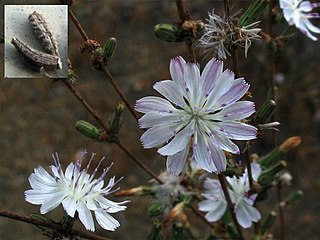
Stephanomeria diegensis is a species of flowering plant in the family Asteraceae known by the common name San Diego wirelettuce. It is native to the coastal hills and ranges of southern California and Baja California, where it grows in many types of open habitat. It evolved as a hybrid of Stephanomeria exigua and S. virgata. Furthermore, it is thought to be the result of homoploid hybrid speciation, which is uncommon. The plant is frequently misidentified as one of its parents, especially if older taxonomic keys are used. This is an erect annual herb easily exceeding two meters in height. Its slender stem has many spreading branches. The basal leaves are linear to lance-shaped and up to 10 centimeters long. The leaves wither early and are absent for most of the year, giving the plant a twiglike appearance. Leaves on the upper stem are small and reduced. The inflorescences are usually clusters of flower heads located at intervals on the stiff branches. Each head has a cylindrical base lined with phyllaries. These are often glandular. The head contains several ray florets, each with an elongated tube and a white or pink-tinged ligule measuring around a centimeter long. The fruit is a grooved achene tipped with a spreading cluster of long, plumelike pappus bristles.

Stephanomeria lactucina is a species of flowering plant in the family Asteraceae known by the common names lettuce wirelettuce and woodland wirelettuce. It is native to Oregon and California, where it grows in coastal and inland mountain ranges, including the Sierra Nevada. It can be found in many types of habitat, including coniferous forests. It is rhizomatous perennial herb producing a slender, erect stem reaching 30 to 60 centimeters in maximum height. The linear or lance-shaped leaves are up to 8 centimeters long and their edges are lined with widely spaced teeth. Solitary flower heads occur on erect peduncles. Each head contains up to 10 ray florets, each with an elongated tube and a fringed pink ligule roughly a centimeter long. The fruit is an achene tipped with a spreading cluster of long, plumelike pappus bristles.
Stephanomeria paniculata is a species of flowering plant in the family Asteraceae known by the common names tufted wirelettuce and stiff-branched wirelettuce. It is native to the northwestern United States, where it grows in many types of habitat, including disturbed areas. It is an annual or biennial herb producing a slender, erect stem with stiff, widely spreading branches toward the top. It is hairless. The leaves are mostly located in a basal rosette, the largest reaching 10 centimeters long. Smaller, linear leaves occur along the upper stem. Flower heads occur singly or in small clusters along the stiff branches. Each head contains 4 to 6 ray florets, each with an elongated tube and a pinkish or lavender ligule up to 1.4 centimeters long. The fruit is an achene tipped with a spreading cluster of long, white pappus bristles.

Tropidocarpum gracile is a species of flowering plant in the family Brassicaceae known by the common name dobie pod. It is native to California and Baja California, where it can be found in many types of habitat from coastal canyons to inland mountains and deserts in chaparral, scrub, woodlands, beaches, valleys, and washes. It is an annual herb producing a decumbent to erect, spreading, branching stem 10 to 50 centimeters in length. It is coated in short and long rough hairs. The basal leaves are up to 10 to 15 centimeters long and are divided into elongated lobes along the edges; leaves higher on the stem are shorter and sometimes less divided. The inflorescence is an open raceme of mustardlike flowers with four petals each about 4 millimeters long. The petals are yellow and sometimes purple-tinged. The fruit is a narrow silique several centimeters in length containing tiny brown seeds.



















